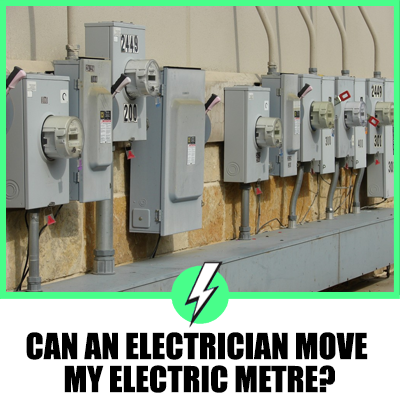Can An Electrician Move My Electric Metre?
Need to move your electrical metre? It’s a common question asked. In this article, we answer that and also look at:
- Who is responsible for the relocation of an electricity metre?
- Is it an electrician or the distribution network operator?
Your first port of call should be your electricity provider; they can move your electricity metre within a 3-metre limit. Your electrician should not try to move the metre, it is not your property! Outside of 3 metres, you will need to contact your distribution network provider for instructions.

Contents
Who owns the electricity metre in my house in the UK?
The electricity supplier. The only way to get your electricity metre moved to a new location that may be more convenient for the homeowner is to contact the electricity supplier.
The electricity supplier will charge you for moving the metre. However, if you want to move the electricity metre to more than 3 metres, you must contact the electricity distributor.
How can I get my electric metre moved for free?
Some moves are free if the metre is an eyesore and in the wrong location the electricity provider may move it to a less obtrusive location such as an airing cupboard free.
If you receive a state pension or are disabled, the electricity can waive the fee for moving the electricity metre.
How much does it cost to move an electricity metre in the UK?
What is the cost of moving an electric metre?
| Description | Duration | Average cost |
| Move your electricity metre 15cm or less | 1-2 hours | £75.00 -£130.00 |
| Move your electricity metre up to 3m | 3-4 hours | £300-£600.00 |
| Move your electricity metre to a different wall | 4-6 hours | £600-£1000.00 |
The charges are quite big, and many average homes may not be able to afford a metre move, so it is worth appealing to the electricity company to waive the fee or to give a substantial discount given that a normal electrician rate is around 75 pounds per hour.
How long does it take to move an electric metre?
It depends on the location of the metre at present and where you need the metre moving to.
You can expect an average time to move the metre and be without electricity of approximately 4 hours, give or take, for the unexpected to crop up during the job.
It may help the power provider contact you via email and send some photos of the present location of the electricity metre and the new location where you would like the metre to be.
The electricity supplier will send a contractor, so photos may help to expedite the process.
How can I hide my electric metre in front of my house?
Electric metres and gas metres are not easy on the eye and can make the outside of your home lose some curb appeal.
The best way to hide an electricity metre is to camouflage it. Having it moved to another location is expensive, so you will need to find a way up if it’s truly worth moving.
You can place some shrubs in pots in front of the electricity metre to camouflage it. Shrubs are great because they stay full and green all year round unless you select a flowering variety.
If they are in pots, it’s easy to swap and change, and you can restore that curb appeal many homeowners look for.
Can you build a box around an electric metre?
It’s a great idea and a good way to hide your unsightly electricity metre.
You will need to build the box or enclosure slightly bigger than the electricity metre, so there is a little airflow around it, although electricity metres do not get hot.
If you make your box or enclosure tamper proof make sure there is a way for your metre reader to access the electricity metre, so you have accurate reading rather than accumulating estimated readings.
You can buy a standard metre box lock and triangle key, which is a good way to keep the box closed and allow access to the metre reader.
Are electric metres waterproof?
To a certain extent, you would not want to stand aiming a jet of water from a hosepipe for too long.
Electricity metres are made from robust plastics that are IP 65 rated. Here is the definition of IP 65:
| IP Rating | Protection | Description | Test method |
| IP65 Enclosure | Able to protect against water jets | Water projected by a 6.3 nozzle against the enclosure from any direction shall not harm the device | Test duration: At least15 minutes Water volume: 12.5 litres per minute Pressure: 30kPA at a distance of 3m |
However, the IP rating does not mean you should put it to the test, water and electricity do not mix, so always take caution.
Can I move my electric fuse box?
Yes, your part P accredited electrician can move your consumer unit/fuse box if required. The cost of moving will vary due to the complexity of the wiring. The electrician will need to trace every circuit before disconnecting the fuse box.
Once the cables are labelled, the electrician can proceed to remove and then replace the fuse box in its new location.
Can metre tails be longer than 3m?
No. The metre tails, as defined as being between the metre position and the fusebox, should not be longer than the required 3 metres.
3 metres is just short of ten feet, so you will need to consider this when changing your fuse box. Don’t assume you have 10 feet to play with because the tails are already coming from the metre to the fusebox.
How do I turn off my main’s electricity in the UK?
Find your consumer unit. It can be found in the garage or close to the front door. Open the lid on the consumer unit. You will see a row of breakers. Hopefully, all the labels are correct with which break is attached to which circuit.
There will be 1 breaker bigger than the rest, and the switch could be red. Underneath this switch is said to be the main power.
Flip the breaker down, all power is now off in your home.





